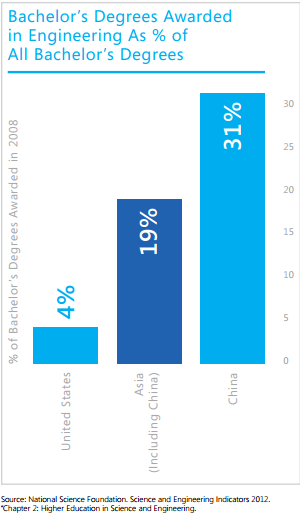
How’s this for a creative twist? Microsoft today suggested that the federal government let employers, including itself, pay higher fees to bring more foreign workers to the U.S. — using the proceeds to educate more homegrown engineers, with the ultimate goal of solving the country’s tech talent crunch in the long run.
The company says the plan could produce up to $500 million annually to help fund U.S. education in science, technology, education and math, while helping companies in the short run by letting them bring in more workers from overseas.
“Ultimately, we can’t expect to build the economy of the future with only the jobs of the past,” says Brad Smith, Microsoft’s general counsel, in a blog post. “We must prepare the next generation for the waves of technological innovation that are on the horizon in every field.”
Even as unemployment rates hover around 8 percent, the U.S. government estimates that there are still 3.7 million open jobs in U.S. economy. Many of those open spots require STEM (science, technology, engineering and mathematics) skills, but tech companies including Microsoft say they have trouble finding qualified workers.
Microsoft says it has more than 6,000 open jobs around the U.S. — including 3,400 for researchers, developers and engineers.
The big takeaway from the document is that Microsoft wants to pair long-term improvements in STEM education in the U.S. with “targeted, short-term, high-skilled immigration reforms.” Microsoft recommends that employers pay $10,000 per worker to bring employees in under visas through the new program, and $15,000 to reduce a backlog of green card applications.
“Put together, this approach can create a more effective national talent strategy to keep jobs in the U.S. by providing a supply of skilled employees who can fill these jobs here, both now and in the future,” the document reads.
The Challenge and The Consequences
The first half of the document explores the challenges and consequences of educating enough STEM-skills Americans. One staggering statistic is that only 4 percent of 2008 bachelor degrees were awarded in engineering in the U.S. in comparison to 19 percent for Asia and 31 percent in China.
Microsoft notes that only 439 students in Washington state took the Advanced Placement (AP) computer science exam, “which in itself is a serious problem.” Only 12 of those students were Hispanic-American, four were African-American and just 99 were female.
“Any solution must include a clear focus on strategies that better encourage and support minority populations and young women to pursue careers in science and engineering,” the document reads.
A National Talent Strategy
Studies show that between 2010 and 2020, the U.S. economy will produce more than 120,000 computing jobs per year requiring a bachelor’s degree. Yet currently, the country has just 40,000 computer science grads annually.
So how does the country produce more talent? In part two of the document, Microsoft identified two areas that address the threats to U.S. employment and economic competitiveness.
- A national “Race to the Future” initiative that creates a more effective STEM pipeline of skilled workers to meet the workforce needs. This requires public-private partnerships and collaboration across all levels of government. Microsoft calls for federal funding for states to strengthen K-12 STEM education, broaden access to computer science in high school and also help college students finish faster and expand higher education capacity to produce more STEM degrees that many 21st century jobs require.
- Microsoft wants to bridge the gap with high-skilled immigration reform to help attract the world’s best minds into the U.S. economy. “There needs to be a path for the best and the brightest innovators in the world to participate in growing U.S. businesses, creating new jobs and strengths our economy,” Microsoft says.



